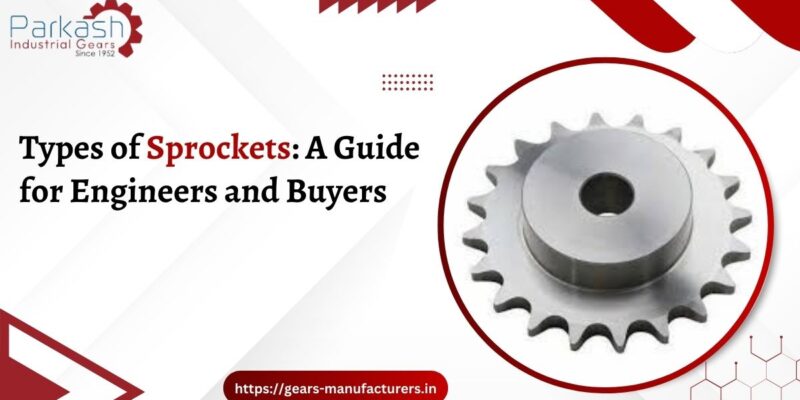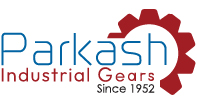
Types of Sprockets: A Guide for Engineers and Buyers
Sprockets are a fundamental part of the majority of mechanical systems, especially those of rotary motion and power transmission. From bicycle machines to industrial equipment, sprockets deliver precise movement and are meant to deliver performance, dependability, and synchronization. Engineers and buyers are able to make the correct decisions when acquiring parts from a solid sprocket gear manufacturer by understanding the different types of sprockets.
This guide explains the various types of sprockets, their applications, functions, and what to look for in the most suitable one for your project.
What is a Sprocket?
A sprocket is a toothed or cogged wheel designed to mate with a chain or a track. Sprockets, in contrast to gears, do not mesh directly with other sprockets. They transfer rotary motion through a chain or belt, which is extensively used in conveyors, bicycles, motorcycles, and industrial machinery.
How to find the best sprocket gear manufacturer or spocket manufacturer?
To identify the best sprocket gear manufacturer or sprocket manufacturer, start with companies having a well-established reputation in precision engineering. The best sprocket gear manufacturer must utilize quality materials and innovative technology. Check for customer feedback, certifications, and the ability to customize. The best sprocket manufacturer will provide timely delivery and adequate after-sales support. It is advisable to compare several sprocket gear manufacturer choices and order samples to ensure you choose the most appropriate sprocket manufacturer for your use.
Why the Proper Sprocket Must Be Used
Using the appropriate type of sprocket guarantees:
- Effective power transfer
- Lower wear and tear on machinery
- Improved life of chains and sprockets
- Improved alignment and performance
As an engineer designing complex machinery or a purchasing specialist ordering reliable parts, it is important to know about sprocket types.
Types of Sprockets Used Commonly
1. Plain Bore Sprockets
They feature a plain, unmachined center bore. They are made for individual modification according to specific shaft sizes. Engineers utilize them for use in precision machining applications.
Applications: Specialized industrial systems and custom machinery.
2. Finished Bore Sprockets
Completed bore sprockets are pre-drilled and keyed with a set screw, ready to fit onto shafts. They conserve machining time and are best for routine applications.
Uses: Conveyor systems, assembly lines, and package handling equipment.
3. Taper Lock Sprockets
They have a hub that makes it easy to fit and remove utilizing taper lock bushes. They offer good shaft grip, rapid installation, and are widely preferred in power-consuming applications.
Applications: Heavy machinery, cement, and mining applications involving high-power transmission.
4. Idler Sprockets
Used for proper tension of the chain and guiding the chain path. Idler sprockets minimize chain vibration and wear.
Applications: Chain-driven machinery and conveyor systems.
5. Double Single Sprockets
These are used to operate two single chains side-by-side. Double single sprockets are made by sprocket gear manufacturer to facilitate synchronized movement of components.
Applications: Packaging equipment, food processing lines, and printing machinery.
6. Segmental Rim Sprockets
These are sprockets that are multi-piece and designed for heavy or large systems. They can be installed or replaced without having to disassemble the whole assembly.
Applications: Heavy conveyor systems and industrial machinery.
7. Multiple Strand Sprockets
These sprockets are designed to carry multiple strands of chain at one time and are utilized when there is a need for greater torque or power transmission.
Applications: Heavy-duty drives and high-capacity conveyors.
8. Silent Chain Sprockets
Employed with silent (inverted tooth) chains, they offer queter operation as well as increased speed performance.
Applications: Advanced automobile engines and advanced machinery systems.
Points to Note When Buying Sprockets
In order to deliver the optimum performance and longevity, buyers and engineers must keep these points in mind:
- Chain Suitability: Ensure that the sprocket is of the same pitch as the chain and roller diameter.
- Material: Choose from stainless steel, cast iron, or carbon steel based on load and environment.
- Number of Teeth: Influences speed, torque, and power transmission efficiency.
- Bore Size and Type: Pick plain, finished, or taper bore based on shaft specifications.
- Load Capacity: Assess the system load and specify sprockets designed to handle it.
- Environment: In wet or corrosive applications, choose stainless or coated sprockets.
Why Work with a Reliable Manufacturer?
A well-established gears manufacturer in India, like Parkash Industrial Gears, guarantees:
- Precision-engineered components
- High-grade materials and quality checks
- Tailor-made solutions for industrial applications
- Prompt delivery and technical assistance
Partnering with a well-known spur gear manufacturer or sprocket gear manufacturer expert provides you with the benefit of trusted engineering and consistent performance on all your projects.
Applications Across Industries
Sprockets find extensive application in:
- Food and beverage processing
- Agricultural machinery
- Automotive transmissions
- Conveyor and logistics systems
- Heavy equipment and mining
Each application necessitates some set of features and materials, and therefore it is important to choose sprockets designed for the intended operating conditions.
Conclusion
An understanding of the different types of sprockets and their corresponding uses helps engineers and buyers make the appropriate decisions that impact performance, longevity, and cost-effectiveness. Whether you require one sprocket or an entire power transmission system, working with an experienced manufacturer like Parkash Industrial Gears ensures that your requirements are met with precision and reliability.
From straight bore to multi strand sprockets, making the right choice can increase your operations’ efficiency and minimize downtime, justifying your investment in the long term.

 FSC India.
FSC India.
This Post Has 0 Comments